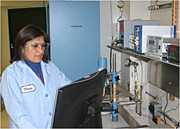- Number 307 |
- March 15, 2010
Isotopic tracers probe methane oxidation

Maria Salazar-Villalpando reviews
an experimental setting in the
photo-electro-catalytic laboratory.
Researchers at DOE's National Energy Technology Laboratory have used an isotopic tracer to probe the identity of oxygen for carbon monoxide (CO) formation during the catalytic partial oxidation of methane to synthesis gas (CO and hydrogen) on Rh/zirconia-doped ceria labeled with 18O2. Understanding the interaction of oxygen species with the catalyst during the conversion of methane to CO and H2 could be useful to design new materials and mitigate carbon deposition.
The researchers are interested in this process because partial oxidation of methane promises to be an excellent alternative technology to steam reforming for syngas production since it shows a high selectivity and conversion. The role of the support in the conversion of methane to syngas over metal-deposited catalysts, however, is still one of the major issues in catalysis.
The researchers’ work revealed that methane is selectively oxidized by lattice oxygen ions from the catalyst to form CO. They performed 18O2 isotopic exchange experiments, as a function of temperature in the 0–850 °C range, on the zirconium-doped ceria oxide support with and without rhodium. They observed that the presence of rhodium considerably accelerates the oxygen exchange with the support; the maximal exchange rates could be observed at lower temperatures, closer to 250 °C. This may be due to oxygen spillover from the metal particles to the oxide.
The researchers also discovered that oxygen conducting materials like the catalyst tested have a much higher oxygen storage capacity and isotopic exchange rate than non-oxygen conducting materials, such as catalysts containing alumina. These findings can be correlated to large-scale processes and explain why ceria-containing catalysts mitigate carbon deposition on the surface of the catalyst and higher stability during long periods of activity.
A peer reviewed paper which explains in detail the work performed at NETL has been published in the International Journal of Hydrogen Energy.
[Linda Morton, 304.285.4543,
Linda.morton@netl.doe.gov]
